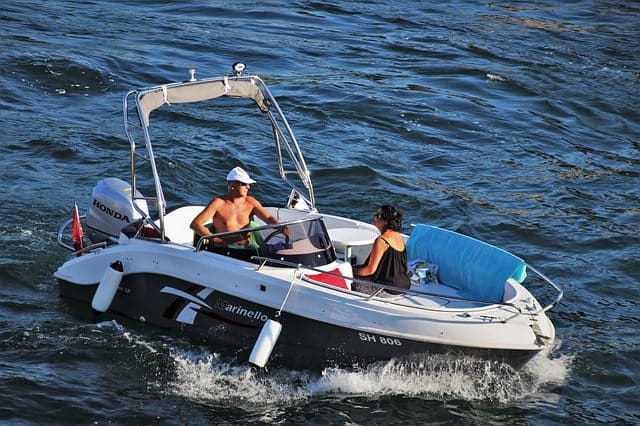Everything You Need to Know About How to Dock a Boat

Everything You Need to Know About How to Dock a Boat

In the United States, there are over 11 million boats registered. People enjoy boating, and being on the water can be very relaxing. But, if you’re operating a boat for the first time, perhaps when you’ve rented a boat on vacation, the fun ends when it is time to dock the boat. If you don’t know how to dock a boat, it can be a very stressful experience. So let’s dispel your fears and take a run through the proper steps for docking a motorboat.
What makes docking boats stressful to those who are inexperienced is the danger involved. It’s very easy to damage a boat if you dock in an improper way. The boat is pushed by the wave action around it, and this can result in collisions with docks, or moored vessels or the shoreline.
How to Dock a Boat
You don’t have to wait until you get to the dock to start getting ready to dock the boat. There are some important steps to prepare for docking. Once you have done these steps, you will be ready to dock your boat.
1. Get Prepared in Advance
Some of these steps will depend on the size of the boat that you are going to dock.
For most small boats, you should start to get the lines ready. You will want to have the lines prepared on the bow (front) and stern (back) of the boat.
These lines will be tied to the boat using the cleats on the boat to the cleats or posts on the dock. Don’t let these lines get tangled, have them coiled and ready, tied to the boat before you arrive at the dock.
The next step is to make sure you have fenders out. These are bumpers made of plastic or rubber that prevent the boat from scraping being damaged by the dock. The bumpers allow you to soften the landing at the dock.
Now that your lines are prepared and your bumpers deployed, you are ready to move the boat into position for docking.
2. Take It Easy!
One of the most important things to remember is that you go at a slow idle speed into the docking area.
On a lake, this will often be in a cove, so don’t want to cause excessive wake by speeding. These wakes can damage docked boats by causing them to slam against the dock or each other.
One of the best ways to make the docking experience a little easier is to accelerate slowly and only for a short time. This prevents the boat from picking up unwanted speed. You should never approach a dock with a faster speed than you would want to collide with it.
You should also be aware of the wind and wave direction. One thing that is much different than parking a car is that a boat is moved by the water it is on. Your boat will be pushed in the direction of the wind, and the water will help carry you in that direction. This can be surprising and quite fast in the wrong conditions.
Now that you have your speed under control, remember to let the boat coast. You should do this by going to neutral, and the boat will maintain its speed for a short time before slowing down. This will help you reach the dock in a soft and easy manner.
3. Tie the Boat Off
A step that is very important is to make sure that your docking lines are secured with the dock.
If they aren’t, the boat could float away or drift into another vessel. You would be liable for both the damage to the boat and the damage it does to anything else.
It is important to tie the boat off properly. You can’t just wrap the rope around the cleat and hope that it will stay secure. Practice this step before you need to, and don’t be afraid to retie it on the dock if you are unsatisfied with how the knot looks.
Double-check to make sure that the fenders, or bumpers, are in position and doing their job. They should be between the side of the boat and the dock. They will prevent the hull of the boat from hitting the dock. This is important to prevent damage to both the dock and the boat.
4. Disembark the Boat
If you don’t have to land the boat on a trailer, your job is over.
You can step off the boat and onto the dock. Be aware that if you are in the ocean, the dock may not be exactly even with the edge of the boat, as the level will change with the tides. Make sure the boat is clear of any possessions you may have, and your job is done. If you rented the boat, you can then return the key and follow any policies that the renter may have.
This process will get easier the more times you do it, but expect that your first time will be very stressful. You can avoid most of this stress and potential financial liability by chartering a yacht. In this case, the boat will have its own crew, and they will know how to dock a boat.
Be Safe When Docking
Remember that water safety doesn’t end just because you are coming in to dock. Wearing a life jacket, especially for children, is important when docking a boat. Accidents do happen on docks, and it is easy to fall off of some docks.
You don’t need to just worry about the boat, but also the passengers of the boat. Falling in between a boat and a dock can be a very easy way to become injured. It can even be fatal, so don’t let the relaxation of boating render you complacent with safety concerns.
Being on the Water Is Rewarding
People have loved being on the water for thousands of years. Whether you love the feel of the ocean or a clam clear lake beneath you, you will enjoy your time on the boat. Chartering anything from a boat to a yacht is a great way to impress guests and have a great time on the water.
Remember, if you are renting a boat for a fun weekend or docking your own boat for the first time, don’t be complacent with safety. Dock your boat in a proper manner and at a low speed, and you will prevent any harm or damage from coming to you and the boat.
We hope this guide proved useful in explaining how to dock a boat. Browse our website for other helpful articles related to this topic.




